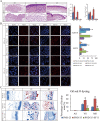The role of NPY2R/NFATc1/DYRK1A regulatory axis in sebaceous glands for sebum synthesis
- PMID: 37501148
- PMCID: PMC10375735
- DOI: 10.1186/s11658-023-00467-4
The role of NPY2R/NFATc1/DYRK1A regulatory axis in sebaceous glands for sebum synthesis
Abstract
Background: Sebaceous glands (SGs) synthesize and secret sebum to protect and moisturize the dermal system via the complicated endocrine modulation. Dysfunction of SG are usually implicated in a number of dermal and inflammatory diseases. However, the molecular mechanism behind the differentiation, development and proliferation of SGs is far away to fully understand.
Methods: Herein, the rat volar and mammary tissues with abundant SGs from female SD rats with (post-natal day (PND)-35) and without puberty onset (PND-25) were arrested, and conducted RNA sequencing. The protein complex of Neuropeptide Y receptor Y2 (NPY2R)/NPY5R/Nuclear factor of activated T cells 1 (NFATc1) was performed by immunoprecipitation, mass spectrum and gel filtration. Genome-wide occupancy of NFATc1 was measured by chromatin immunoprecipitation sequencing. Target proteins' expression and localization was detected by western blot and immunofluorescence.
Results: NPY2R gene was significantly up-regulated in volar and mammary SGs of PND-25. A special protein complex of NPY2R/NPY5R/NFATc1 in PND-25. NFATc1 was dephosphorylated and activated, then localized into nucleus to exert as a transcription factor in volar SGs of PND-35. NFATc1 was especially binding at enhancer regions to facilitate the distal SG and sebum related genes' transcription. Dual specificity tyrosine phosphorylation regulated kinase 1A (DYRK1A) contributed to NFATc1 phosphorylation in PND-25, and inactivated of DYRK1A resulted in NFATc1 dephosphorylation and nuclear localization in PND-35.
Conclusions: Our findings unmask the new role of NPY2R/NFATc1/DYRK1A in pubertal SG, and are of benefit to advanced understanding the molecular mechanism of SGs' function after puberty, and provide some theoretical basis for the treatment of acne vulgaris from the perspective of hormone regulation.
Keywords: DYRK1A; NFATc1; NPY2R; NPY5R; Puberty onset; Sebaceous glands.
© 2023. The Author(s).
Conflict of interest statement
The authors declare that they have no competing interests.
Figures





Similar articles
-
Homeostasis of the sebaceous gland and mechanisms of acne pathogenesis.Br J Dermatol. 2019 Oct;181(4):677-690. doi: 10.1111/bjd.17981. Epub 2019 May 6. Br J Dermatol. 2019. PMID: 31056753 Review.
-
Neuroendocrinology and neurobiology of sebaceous glands.Biol Rev Camb Philos Soc. 2020 Jun;95(3):592-624. doi: 10.1111/brv.12579. Epub 2020 Jan 22. Biol Rev Camb Philos Soc. 2020. PMID: 31970855 Review.
-
Acne and sebaceous gland function.Clin Dermatol. 2004 Sep-Oct;22(5):360-6. doi: 10.1016/j.clindermatol.2004.03.004. Clin Dermatol. 2004. PMID: 15556719 Review.
-
The melanocortin 5 receptor is expressed in human sebaceous glands and rat preputial cells.J Invest Dermatol. 2000 Oct;115(4):614-9. doi: 10.1046/j.1523-1747.2000.00094.x. J Invest Dermatol. 2000. PMID: 10998132
-
A practical guide for the study of human and murine sebaceous glands in situ.Exp Dermatol. 2013 Oct;22(10):631-7. doi: 10.1111/exd.12207. Exp Dermatol. 2013. PMID: 24079731 Review.
Cited by
-
CD39 Contributes to the Ability of Cell Invasion in Heterogeneity of Colorectal Cancer.J Cell Mol Med. 2025 Mar;29(5):e70486. doi: 10.1111/jcmm.70486. J Cell Mol Med. 2025. PMID: 40052646 Free PMC article.
-
Early Exposure of an Infantile Rat to Sex-Related Content Induces Precocious Puberty by Activation of Cholinergic Neurons in the Amygdala and KNDy Neurons in the Arcuate Nucleus.ACS Omega. 2025 Jul 8;10(28):30327-30334. doi: 10.1021/acsomega.5c01531. eCollection 2025 Jul 22. ACS Omega. 2025. PMID: 40727794 Free PMC article.
-
PD-1/PD-L1 axis: implications in immune regulation, cancer progression, and translational applications.J Mol Med (Berl). 2024 Aug;102(8):987-1000. doi: 10.1007/s00109-024-02463-3. Epub 2024 Jun 27. J Mol Med (Berl). 2024. PMID: 38935130 Review.
-
Generation of B7-H3 isoform regulated by ANXA2/NSUN2/YBX1 axis in human glioma.J Cell Mol Med. 2024 Jul;28(14):e18575. doi: 10.1111/jcmm.18575. J Cell Mol Med. 2024. PMID: 39048916 Free PMC article.
References
-
- Wang T, Zhou Z, Luo E, Zhong J, Zhao D, Dong H, Yao B. Comprehensive RNA sequencing in primary murine keratinocytes and fibroblasts identifies novel biomarkers and provides potential therapeutic targets for skin-related diseases. Cell Mol Biol Lett. 2021;26:42. doi: 10.1186/s11658-021-00285-6. - DOI - PMC - PubMed
Publication types
MeSH terms
Substances
Grants and funding
- SKYD2022023/Suzhou Medical health science and technology innovation project
- SKJY2021016/Suzhou Medical health science and technology innovation project
- XYFY202219/Science and Technology Planning Fund of Affiliated Hospital of Xuzhou Medical University
- XYFM202217/Science and Technology Planning Fund of Affiliated Hospital of Xuzhou Medical University
- GSWS2022111/Gusu Health Talent Research Project
LinkOut - more resources
Full Text Sources
Medical
Molecular Biology Databases
Miscellaneous

